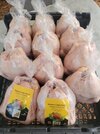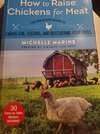Ikarus1
Avtomat Krishna-kov
Built this 10x12ft Salatin style meat bird tractor to replace my old 8x10 cattle panel hoop coop. It is much Iighter and stronger, and with the right dolly (not yet built) this is easily moved in 60 secs or less.
This build all but required the use of a decent tablesaw, and I got a great deal on a 10" Metabo aka Hitachi jobsaw earlier this year from Lowes. Ripping 12ft 1x6" treated was so much easier than trying to use a circular saw.
I used plans from the Polyface Designs book but modified it a bit. Because 48"x12ft aluminum is stupid expensive and hard to find, I used vinyl panels throughout. I also enclosed the entire perimeter with wire even behind the side vinyl. I DO highly recommend the Plasson commercial type gravity water setup, since Cornish Cross meatbirds drink ALOT of water. It keeps the water supply clean and out of the coop which means healthier birds. This is only my second batch this year but this watering setup is much less work. Pour water in the bucket and you're basically done. I just added a cheap lid to keep trash out
My current homestead poultry production plan is never to buy eggs or chicken in a grocery store again. And possibly sale sail cell some excess since we can raise and process 1000 a year without govt inspections.





This build all but required the use of a decent tablesaw, and I got a great deal on a 10" Metabo aka Hitachi jobsaw earlier this year from Lowes. Ripping 12ft 1x6" treated was so much easier than trying to use a circular saw.
I used plans from the Polyface Designs book but modified it a bit. Because 48"x12ft aluminum is stupid expensive and hard to find, I used vinyl panels throughout. I also enclosed the entire perimeter with wire even behind the side vinyl. I DO highly recommend the Plasson commercial type gravity water setup, since Cornish Cross meatbirds drink ALOT of water. It keeps the water supply clean and out of the coop which means healthier birds. This is only my second batch this year but this watering setup is much less work. Pour water in the bucket and you're basically done. I just added a cheap lid to keep trash out
My current homestead poultry production plan is never to buy eggs or chicken in a grocery store again. And possibly sale sail cell some excess since we can raise and process 1000 a year without govt inspections.












